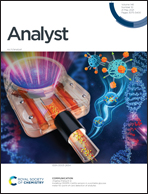Comparing the abundance of HClO in cancer/normal cells and visualizing in vivo using a mitochondria-targeted ultra-fast fluorescent probe†
Abstract
Organisms are operating and evolving with a highly sophisticated and intelligent defense mechanism to resist bacterial and viral infections. This process involves a variety of reactive oxygen species (ROS), and they coordinate with each other to support different physiological activities. Due to its strong oxidizing properties, hypochlorous acid (HClO), a part of ROS, is a powerful antimicrobial agent in living organisms and exerts a crucial role in the immune system. However, the excessive production of HClO can cause cell damage and even cell death. Herein, we combined benzene-conjugated benzopyrylium as the fluorophore and dimethylthiocarbamoyl chloride as the recognition site to rationally design a probe (BBD). The fluorescence of the probe was quenched based on an effective PET molecular mechanism. Surprisingly, BBD exhibited a turn-on red fluorescence signal for HClO with ultra-fast response (5 s) and high selectivity. Moreover, BBD located mitochondria well and it was found that the abundance of HClO is higher in HeLa cells compared to that in normal cells. Finally, BBD was successfully applied to the visualization of HClO in zebrafish and nude mice.



 Please wait while we load your content...
Please wait while we load your content...